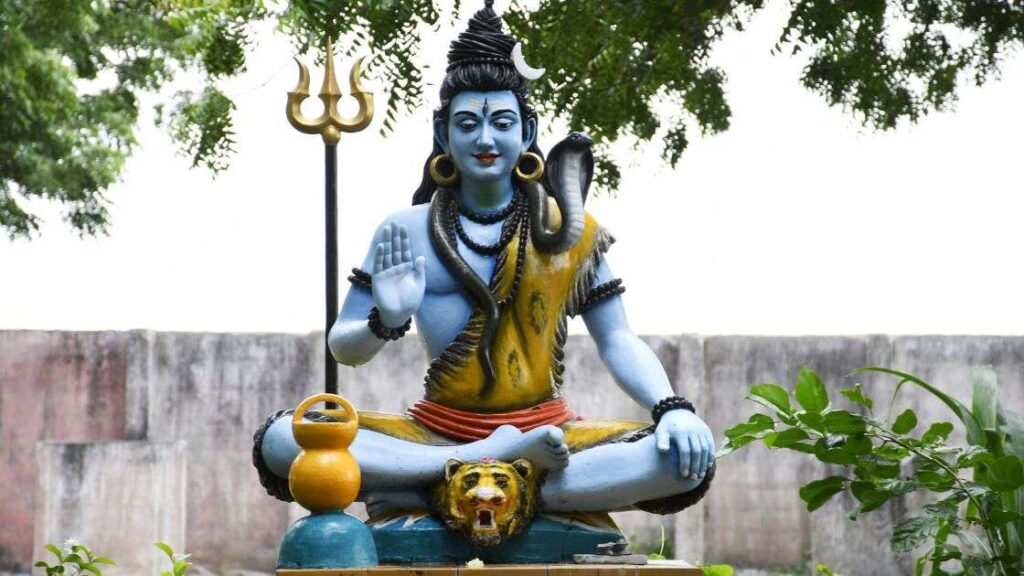Shiva (Eshwar)
I’ll be writing about the Destroyer (Shiva) today in the Trinity series. The other two (Brahma and Vishnu) are the creators and keepers of the universe, according to various Puranas.
His mission is to destroy the world and dissolve it into nothingness at the end of time. Shiva is a vast void of space. Everything comes from the womb, which is the state of unconsciousness into which everything is sucked. This means everything comes from Shiva and goes back to Shiva. He is non-being, not being. He is not portrayed as a light but as darkness, which is a much stronger possibility than light. He is calm as Bolenath and fierce as Kala bhairava and Veerabhadra. Calming and extreme qualities bring out the balance in his life, Parvathi Devi, and they are insufficient without one another. Shiva is also known as a cosmic dancer (Nataraja), Ardhanarishvara, and the union of Shiva and his consort in a single body that is half male and half female. He is also known as the Pashupati Animal Master. He is the Lord of the Soul and Nature. Shivaratri is observed by Hindus, yogis, and Shaivites. Worshipping Bolenath, meditating, and celebrating Maheshwara’s Bhakti are all appropriate activities for devotees.
When you chant OM and meditate with devotion, the environment becomes completely silent, and the truth about our purpose for being here on Earth is revealed in silence, according to our manuscripts.
Shiva”s appearance
He is a significant Hindu deity, revered by the vast majority of Indians. It has a naked ash-covered body. He is known as Digambara. Everything in nature is subjected to being reduced to ashes. The physical universe is represented by ashes. His three matted locks on Shiva’s head represent the integration of three ideal requisite energies of yoga. That is mental, physical, and spiritual well-being. He summoned Akash Ganga from heaven and ran it through his hair. The Ganga River symbolizes purity and peace, annihilating sin, banishing oblivion, and bestowing knowledge on devotees. He is known as Jatta Dahar. The Crescent Moon, an ornament on the Lord’s head, is an essential component of Shiva.
Eyes: He is also known as Tryambaka deva or Trinethra, and he has three eyes, one for the sun, one for the moon, and one for fire.
Earrings or kundalalu signify that he is beyond ordinary perception. Earrings differ from one ear to another ear. The left ear kundala of the Lord is the type used by women, and the right ear is the type used by men, symbolizing the Shiva and Shakthi principles of creation.
Vasuki : Vasuki Naga, the serpent adorning his neck, is coiled three times around the Lord’s neck and looks towards his right side. In cycles, it represents the past, present, and future.
Rudraksha Mala : A Rudraksha mala is worn around his neck as a symbol of his firm adherence to cosmic laws. It has 108 beads that represent the elements that were used in the creation of the Universe. The right hand is in the Varaha Mudra position, which represents a boon-giving and blessing pose.
Trishul: The Trishul (trident) represents the three fundamentals of iccha (will). (Kriya)action and jnana (knowledge).
Damarukam : The Damaru produces the AUM sound, which represents Nada, and can be heard during deep meditation.
The kamadalam, or water pot, is made of pumpkin and contains nectar, which is displayed on the ground next to Shiva. Nandi, or the bull, represents both ignorance and power. Shiva sits on a tiger’s skin to demonstrate his omnipotence. It also represents the divine power over animal intuitions. Shiva’s frequent appearances at the cremation ground indicate that he is the physical world’s controller of death.
Festivals of Lord Shiva
According to the Hindu calendar, Mahashivaratri is a festival celebrated every year in the Shukla Paksha, of the month of Maagha or Phalguna.
Shiva Mantra
The benefits of reciting the Shiva mantra on auspicious days such as Pradosham and Maha Shiva Ratri are multiplied exponentially.
oṁ tryambakaṁ yajāmahe sugandhiṁ puṣṭi-vardhanam ǀ
urvārukam-iva bandhanān mṛtyormukṣīya māmṛtāt ǁ”
Other incarnations of Shiva are
- Ardhnaarishwar Avtaar
- Nandi Avtaar
- Sharabh Avtaar
- Grihpati Avtaar
- Neel Kanth & Yaksheshwar Avtaar
- Durvasha Avtaar
- Mahesh Avtaar
- Hanuman Avtaar
- Rishabh Avtaar
- Piplaad Avtaar
- Vaishyanath Avtaar
- Dwijeshwar Avtaar
- Yatinath Avtaar
- Krishna Darshan Avtaar
- Awdhuteshwar Avtaar
- Bhichhuwarya Avtaar
- Sureshwar Avtaar
- Bramhchoti Avtaar
- Sunatnartak Avtaar
- Sadhu Avtaar
- Vibhuashwathama Avtaar
- Kiraat Avtaar
Shiva Temples
The 12 Jyotirlinga temples as mentioned in the Shiva Purana are as listed below:
- Somnath, Gujarat
- Mallikarjuna Swamy, Andhra Pradesh
- Mahakaleshwar, Madhya Pradesh
- Omkareshwar Omkareshwar Temple, Madhya Pradesh
- Kedarnath, Uttarakhand
- Bhimashankar, Maharashtra
- Kashi Vishwanath, Uttar Pradesh
- Trimbakeshwar Shiva Temple, Maharashtra
- Vaidyanathdeogarh, Jharkhand
- Nageshwar, Uttarakhand
- Ramanathaswamy, Rameswaram, Tamil Nadu
- Grishneshwar, Ellora, Maharashtra
Content Specific Keywords : lord shiva images, lord shiva hd wallpapers, lord shiva hd images, lord shiva wallpaper, lord shiva names, lord shiva images hd 1080p download, lord shiva 8k ultra hd wallpapers, lord shiva 4k images download, signs that lord shiva is with you, beautiful photos of lord shiva, who can defeat lord shiva, rare names lord shiva, different names of lord shiva, 1008 names of lord shiva in hindi, who is lord shiva daughter, lord shiva age, signs that lord shiva is with you.


